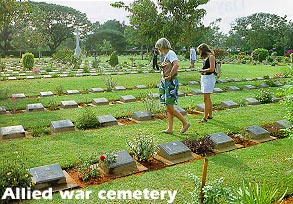|
On
one occasion a party of 60, mostly stretcher cases, were dumped off a train
in a paddy field some 2 miles from the Camp in the pouring rain at 0300hrs......
As a typical example, I can remember one man who was so thin that he could
be lifted easily in one arm. His hair was growing down his back and was
full of maggots; his clothing consisted of a ragged pair of shorts soaked
with dysentery excreta; he was lousy and covered with flies all the time.
He was so weak that he was unable to lift his head to brush away the flies
which were clustered on his eyes and on the sore places of his body. I
forced the Japanese Staff to come and look at these parties, which could
be smelt for some hundreds of yards, but with the exception of the Camp
Comdt, they showed no signs of sympathy, and sometimes merely laughed.
|





